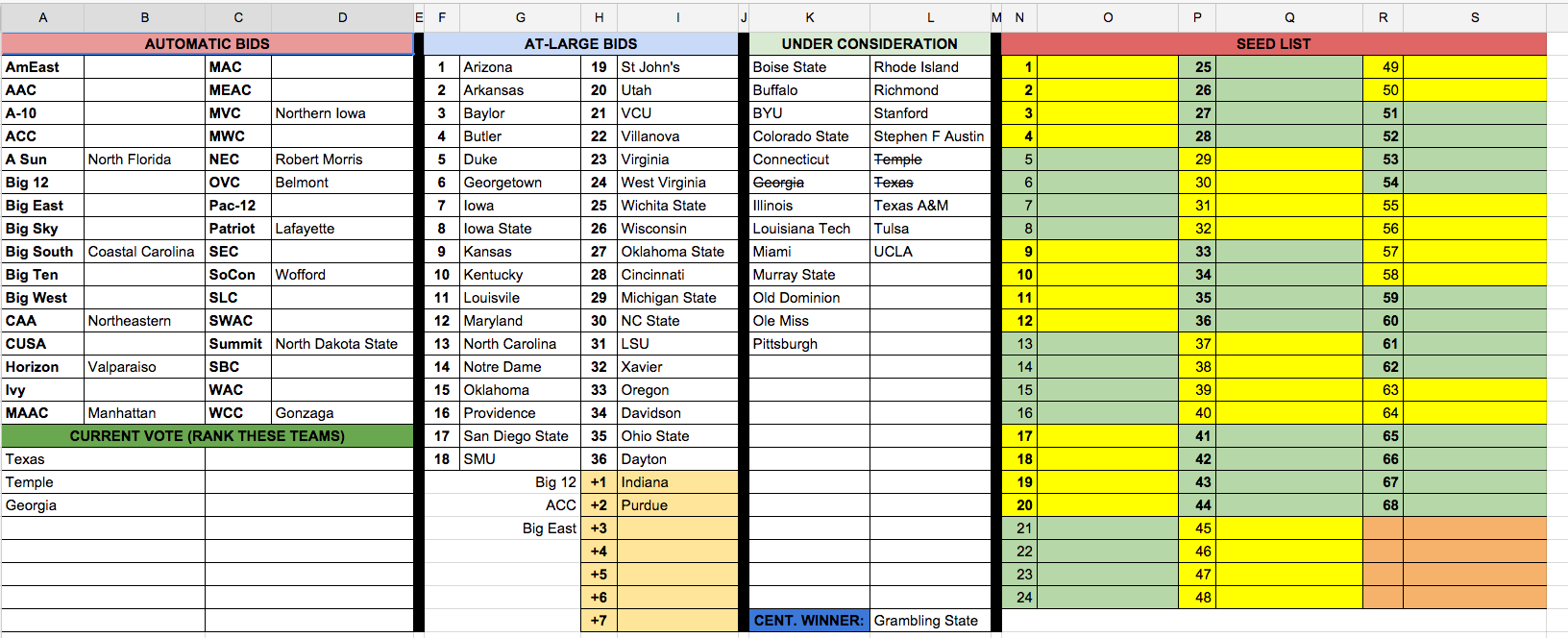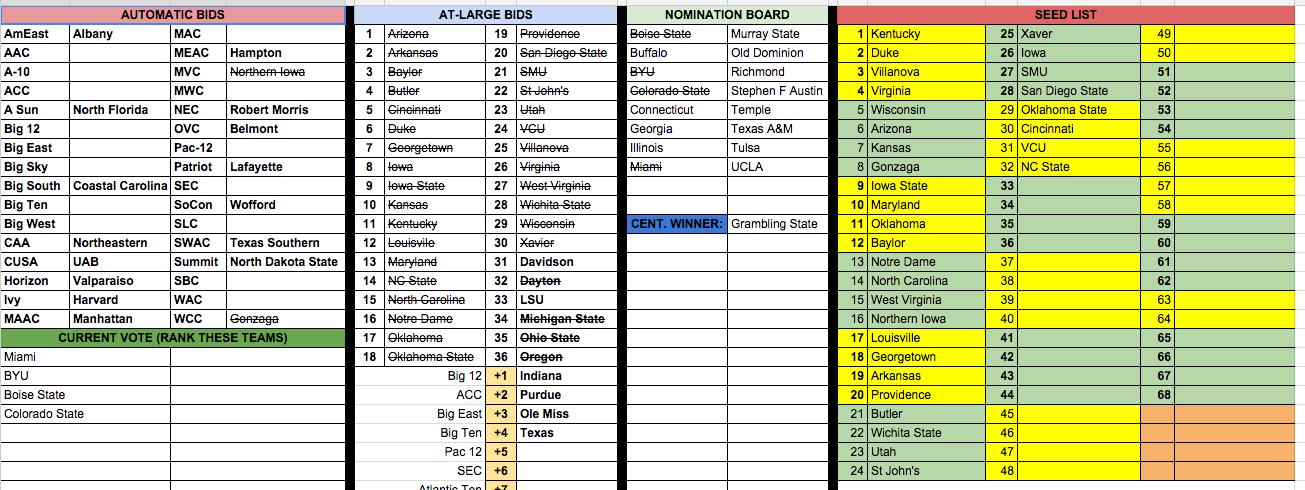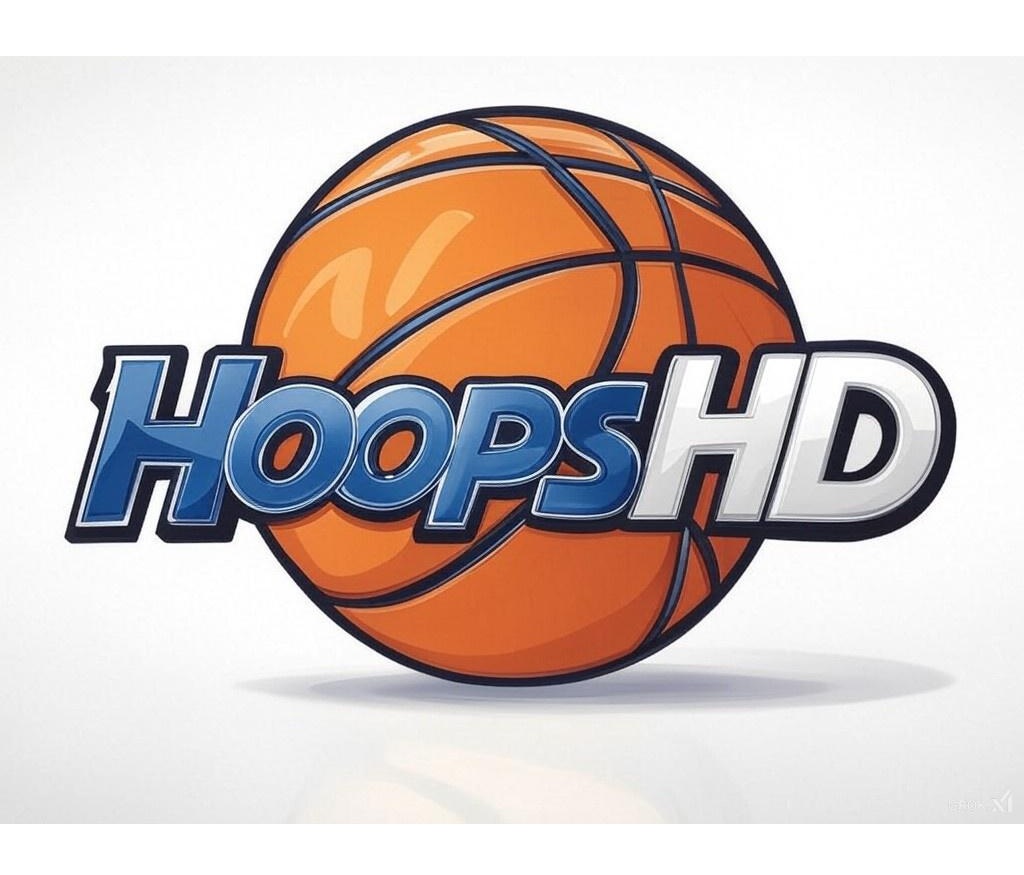-To watch our Championship Week Video Notebook from last night – CLICK HERE
-To see Chad Sherwood’s updated personal bracket – CLICK HERE
THE PROCEDURE
As we do every year, we have convened a committee of ten individuals who intently follow college basketball, and are replicating (at least to a point) the selection process that the actual Selection Committee goes through, while keeping a similar timeline.
The first order of business was to select 36 teams that we feel are in the field no matter what happens in their conference tournaments. This is accomplished by each of the ten committee members voting for UP TO 36 teams whom they feel are in the tournament. If eight of the ten members vote for a team, that team is placed into the field. For every team that gets seven or fewer votes, that team is placed on the “Nomination Board,” which really should be called the “Consideration Board,” but is instead called the “Nomination Board.”
A second vote is taken where committee members vote for teams who they think should be considered for inclusion, but are not absolutely certain of yet. Any team that gets three out of ten votes is then placed on the “Nomination Board” along with the teams who didn’t make the first cut.
After our initial ballot, there were 26 teams on the Tournament Board (Arizona, Arkansas, Baylor, Butler, Duke, Georgetown, Iowa, Iowa State, Kansas, Kentucky, Louisville, Maryland, North Carolina, Notre Dame, Oklahoma, Providence, San Diego State, SMU, Saint John’s, Utah, VCU, Villanova, Virginia, West Virginia, Wichita State and Wisconsin).
So, the next task was to add ten more teams to the board. We did this by having each member pick the top eight teams (without ranking them) from the nomination board. The eight teams that got the most votes were then submitted to each committee member, and ranked 1-thru-8 (after much discussion and debate). The top four teams were placed into the field. The four that didn’t make it were carried over. The committee selected eight more teams that were not carried over, the top four of those eight joined the four carry overs, and the teams were once again ranked 1-thru-8, with the top four getting in.
With the Big Twelve, ACC and Big East having all their remaining teams already on the tournament board, that opened up three more spots for at-large teams. Every time one of the 36 teams wins a conference tournament, it opens up another spot.
The below graphic is a replica of what the actual Selection Committee Board looks like. Well, it’s a replica of the layout. The teams on it are the teams we’ve selected while replicating the process. I must stress that these teams have not yet been ranked. They have merely been listed.

PUPPET RAMBLINGS!!
-I respect all the individuals on our mock committee. Well, that’s not true, but they don’t respect me either so I guess that makes us even. Some people just don’t like puppets!! Having said that, we are very far apart in some of our opinions. This is important, because it is very possible that the real committee has members who also do not agree with the consensus.
-I don’t see the love for Indiana. When I see a team win so few true road games, it gives me pause. I realize they have good wins, but I don’t think the best way to measure a team is to just count up top 50 and top 100 wins. They have a home win against Maryland, which is very good, but Maryland is 6-4 in true road games. So, while it’s a good win, it’s not quite the same as if they had won at Maryland. Ohio State is just 3-6 on the road, and none of their wins came against NIT teams, much less strong NCAA teams, so do we really need to be giving Indiana a lot of credit for that win?? I would argue no. I did argue no. But, I lost. That’s how committees work.
-Iona was voted off of the Nomination Board almost instantly, yet Murray State was left up. I was the only person that voted to keep them on. The logic was that we didn’t think they’d make the field, so why not just take them off?? I agree that they PROBABLY won’t make it, but I felt they were at least worth looking at. We voted, I lost. Again, that’s how committees work. For more on Iona –CLICK HERE TO READ MY RANT FROM YESTERDAY
-Finally, I like Boise State, yet we have not voted them in yet. I understand that they don’t have an abundance of high RPI wins, but what they do have is a lot of decent ones. They’re the only team that won at San Diego State, who is not as good as Maryland, but I would argue that being the only team to win at San Diego State is better than being one of four teams to beat Maryland at home. I argued that, and lost. That’s how committees work.
-I’ve voiced what I disagreed with, but overall I agree with most of what we’ve done. I also feel that the arguments that I don’t agree with are still well reasoned and well informed.
-Tonight, we will begin the seeding process, and we will add at least one more team to our field.
-I’ve said my piece, and am now opening this up to the other nine members of the committee to see if they would like to add any comments. They will be posted below, so be sure and check back throughout the day. Some will talk about how wrong I am, and that’s fine, even though they’re wrong because anyone who disagrees with me probably is.
OTHER COMMITTEE COMMENTS
Chad:
-After further consideration, I actually agree with David about Indiana. The Committee can vote a team back from At-Large and down to Under Consideration if 8 out of 10 members agree to so do (and that team could later be voted back into the field again). If memory serves, our HOOPS HD Committee did this last year. I intend to start this evening’s session with a motion to do the same for the Hoosiers.
-Also David is clearly completely infatuated with Tim Cluess’ mustache, probably because puppets tend to be unable to grow any facial hair. Iona has four sub-150 losses on their profile and is not even worth mentioning in the same breath as Murray State. I do no believe either teams belongs in the field, but I see the argument for Murray being on the “Nomination Board”. I do not see even that for Iona.





Hoops HD Mock Selection Committee Report: Sunday, March 15th
Bracket Below Updated at 4pm, est
For our most recent, and final, Championship Week Video Notebook, and Viewing Guide for today’s games – CLICK HERE
Last night, the committee selected the entire field, seeded the entire field, scrubbed the entire field, and set up contingency plans for the games today. UConn was not selected as an at-large, but if they win they will land at #47 on the seed list, which places them on the #12 line. If they lose, then another spot in the field will open up, and Temple will make the field as our final at-large selection. The fact that they are in the same conference as UConn is a coincidence. That did not factor in to the decision.
As you can see below, the teams that were considered but did not make the field as at-larges are Colorado State, UConn (who is still playing), Georgia, Illinois, Murray State, Texas A&M, Tulsa and UCLA.
I realize that many bracketology sites are projecting that Georgia is not only in the field, but safely in the field. Quite frankly, we don’t care. If the actual committee takes them it would not surprise me because I see how a case can be made, and I see how they’ve done things that this committee has a tendency to like. Same with Colorado State and Tulsa. Our committee did not like them. Although we go through the same process the real committee does and use the same procedures and information, we really aren’t all that concerned with guessing what a committee of people we don’t really know are going to do. We are more into analysis than we are fortune telling, and aren’t really worried too much about what our final “score” is when it comes to matching what the real committee does.
Having said that, I do think Wisconsin will get a #1 seed from the real committee if they win today, and perhaps even if they don’t. I also think that Colorado State will make the real committee’s field. We are going to scrub our bracket one more time, and we make one or both of those changes ourselves, but I’d venture to say that Colorado State probably will not be voted in to ours.
Below is what our board looked like after we finished last night. Below that is a preliminary bracket based on our seed list, but it is not the final bracket. I checked it and I don’t think there are any mistakes, but it was 4am, I don’t have the software that our chairman has that immediately point out errors, so if there are any, a thousand pardons. I realize Butler v Indiana is a rematch, and that the committee likes to avoid those, but in this case I felt I had to move too much around to avoid it. That, and who the hell wouldn’t want to see those two go at it again??
Georgia Southern and Georgia State are also accounted for. Georgia State will be a #14 seed, whereas Georgia Southern would be a #15 seed.
THE BOARD
THIS IS OUR FINAL BRACKET IF SMU BEATS UCONN. We had to move BYU v Miami from the #11 down to the #12 line, and Wofford up to the #11 line to meet bracketing rules
THIS IS OUR BRACKET IF UCONN BEATS SMU. No teams had to be moved off their natural seed lines
NOTES ON THE BRACKET
-The biggest teams we had disagreements on were Butler, Louisville and SMU. Some of us felt that Butler was clearly better than Louisville, and made several motions to get the two switch, but by that point we needed seven out of ten committee members to agree with the motion and it could not pass.
-Kyle Lamb and Lee Delvecchio were very much against SMU, and they ended up motioning several times to move them down. Some were against it, but they were able to convince the majority, so the teams were moved.
-We do feel that the real selection committee will give Wisconsin a #1 seed, and that they will either replace Duke or Virginia. Some of us feel Colorado State is getting in to the real tournament, but not everyone. Many of us also feel Georgia is getting in to the real tournament, but that they do not belong in. We feel they will replace either BYU or Temple, most likely BYU.
It’s up to the committee now. It’s called Bracketology, but I actually hate that term. It’s a qualitative process that basically consists of ten individuals conducting a year long examination. You can quantify what it will approximately look like, but you cannot quantify the entire thing.